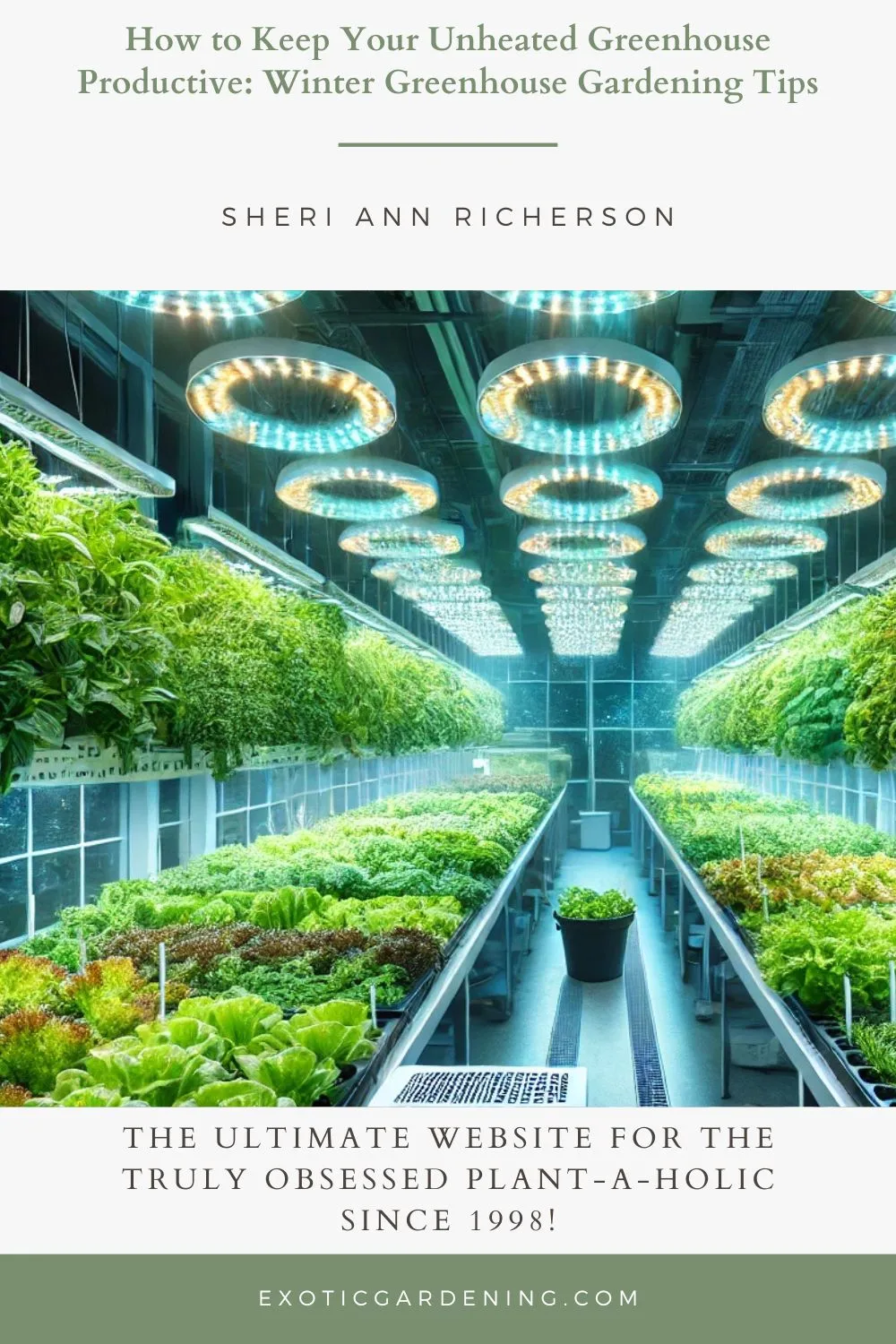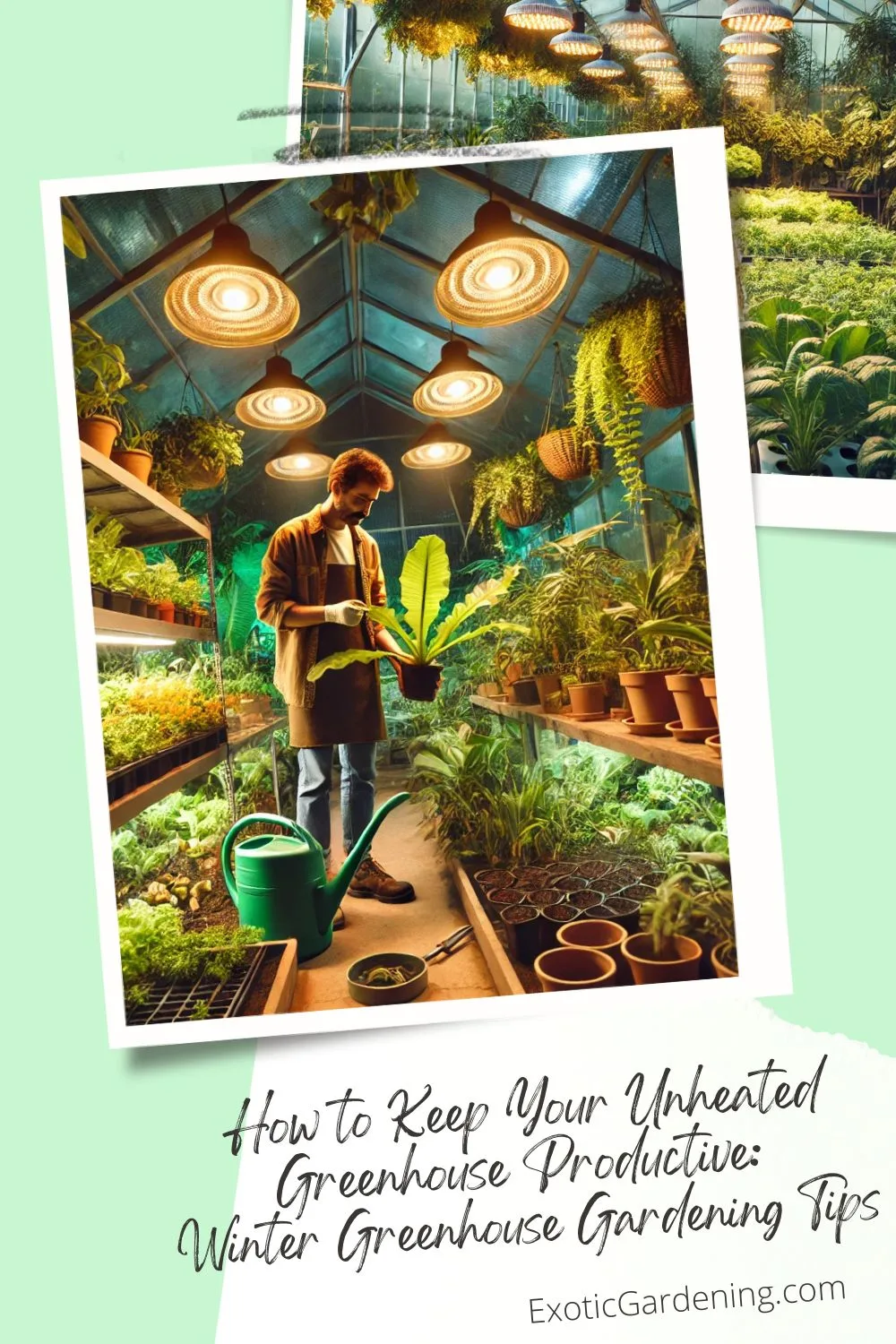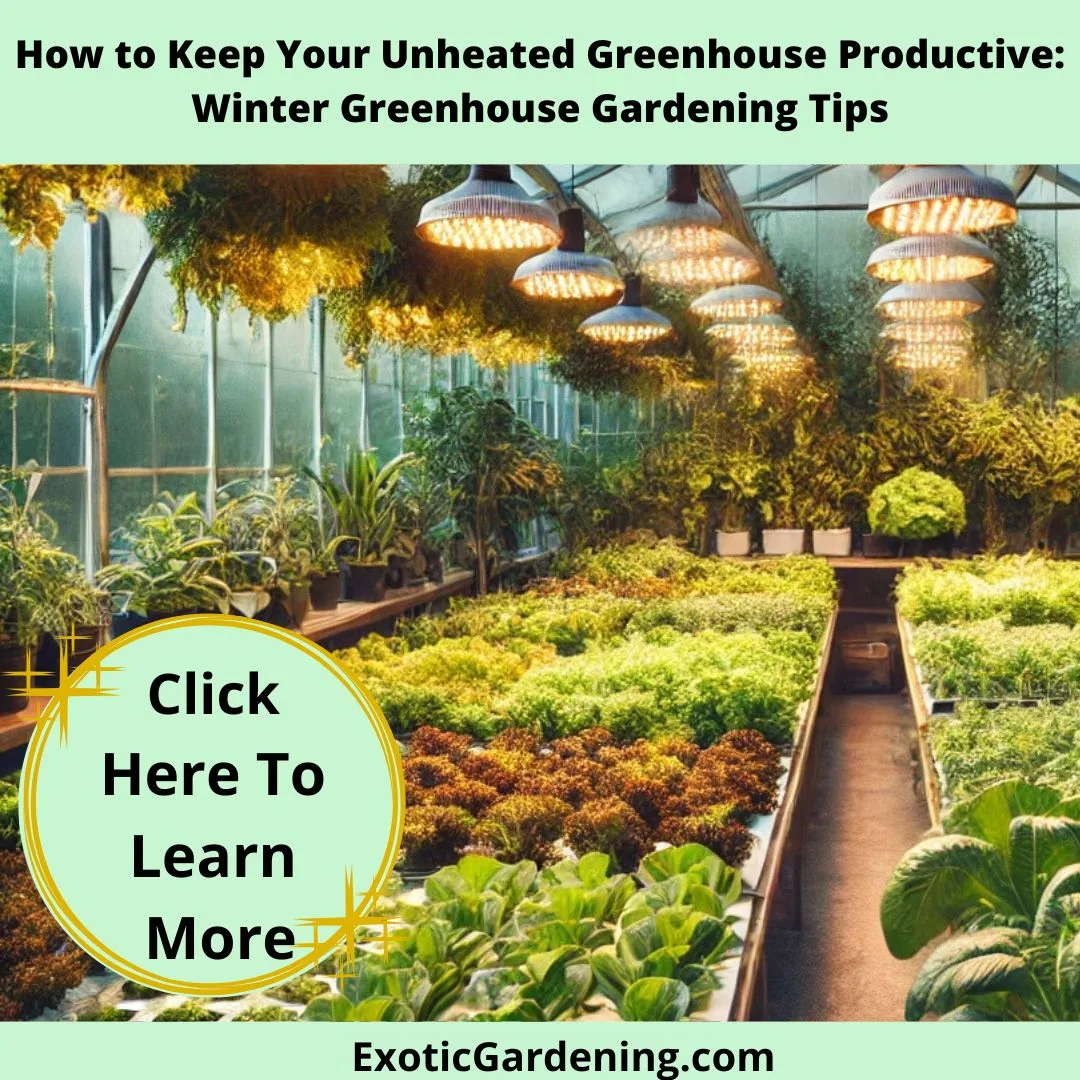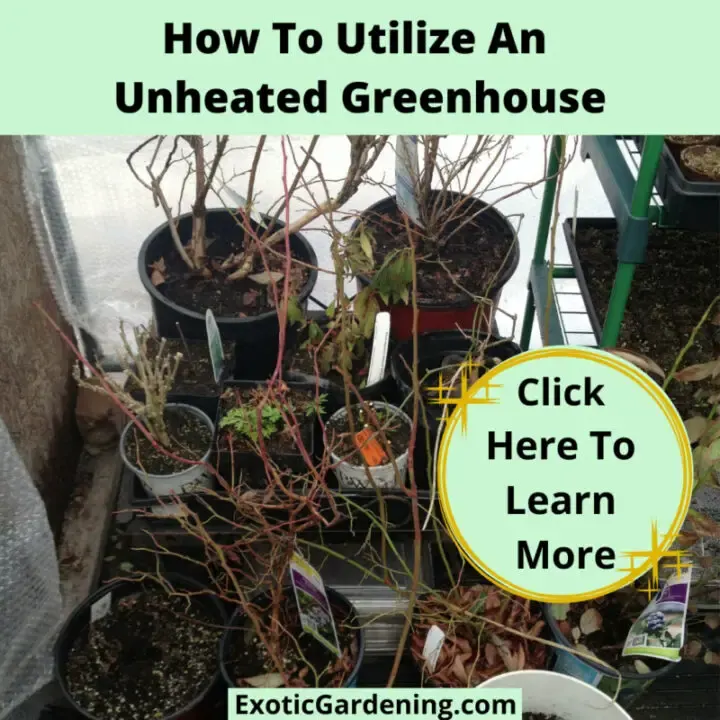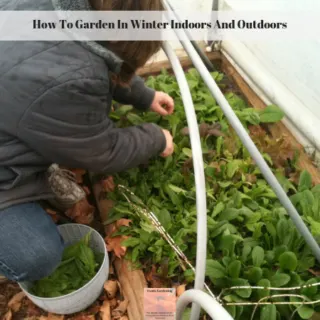Winter greenhouse gardening doesn’t have to mark the end of your growing season!
Even if your greenhouse isn’t heated, you can still grow fresh, cold-hardy crops like spinach and Asian greens during the chilliest months.
The secret lies in creating the right environment for your plants. Insulation, strategic watering, and clever heat-storing techniques can transform your space into a productive winter garden.
By focusing on winter-friendly crops and making simple adjustments, you can harness natural resources to maintain a stable growing environment.
Have you ever thought about using bubble wrap for insulation or adding thermal mass like water-filled barrels to retain warmth?
These small changes can make a big difference.
Curious about how to keep your unheated greenhouse thriving all winter long?
Let’s dive into practical tips and strategies to help you extend your growing season, keep your plants happy, and enjoy fresh produce year-round.
The Benefits of Winter Greenhouse Gardening
Unheated greenhouses are an excellent way to extend your growing season while keeping costs low.
Unlike heated greenhouses, which require a significant investment in energy, an unheated greenhouse relies on natural sunlight and strategic planning to maintain productivity.
This makes winter greenhouse gardening an affordable and eco-friendly solution for year-round gardening.
By focusing on cold-tolerant crops like spinach, kale, and mache, you can grow fresh, nutrient-packed produce even when outdoor gardens are covered in frost.
These fresh greens and root vegetables provide a reliable food source during the colder months, reducing your dependence on store-bought produce and lowering your grocery bills.
Additionally, winter greenhouse gardening helps reduce food waste by enabling you to harvest exactly what you need.
You can also experiment with growing new crops, improving your gardening skills while maintaining a steady supply of healthy, homegrown food.
Plus, it’s deeply rewarding to see vibrant plants thriving while the rest of your landscape lies dormant!
Start With the Right Crops
When it comes to winter greenhouse gardening, choosing the right crops is the foundation of success.
Not all plants can handle the challenges of shorter days, cooler temperatures, and less intense sunlight, but many cold-hardy varieties thrive in these conditions.
These resilient plants are your best allies for maintaining a productive unheated greenhouse during the colder months.
Leafy greens like spinach, mache (also called corn salad), and kale are excellent choices.
They tolerate lower light levels and cooler temperatures, growing steadily even when growth slows down outdoors.
Asian greens such as bok choy and tatsoi are equally well-suited for winter conditions, offering diversity and flavor to your harvest.
Root crops, including radishes and carrots, are also great options.
With some added protection, like a frost blanket or cloche, they can thrive in an unheated greenhouse.
These crops are less likely to succumb to frost damage and can store well after harvest, extending your fresh food supply.
Additional Crops for Winter Greenhouse Gardening:
- Swiss chard
- Mustard greens
- Collard greens
- Scallions (green onions)
- Turnips
- Beets
- Parsley
- Cilantro
- Endive and escarole
- Cabbage
By diversifying your greenhouse garden with these crops, you’ll create a robust, productive space that provides a wide variety of fresh, nutritious food throughout the winter.
Each plant offers unique benefits, so mix and match to find what works best for your growing conditions and tastes.
Insulate Effectively
When it comes to winter greenhouse gardening, insulation is your first line of defense against the cold.
Retaining heat is crucial for maintaining a stable growing environment, and with the right strategies, you can create a cozy space for your plants even during the frostiest nights.
Best Insulation Techniques
- Bubble Wrap
Cover your greenhouse walls and roof with bubble wrap to trap heat. This lightweight material is inexpensive, easy to apply, and highly effective at reducing heat loss. Use large bubble wrap for better insulation and secure it with clips or tape. For extra durability, invest in UV-stabilized bubble wrap designed for outdoor use. - Straw Bales
Stack straw bales along the base of your greenhouse walls. These act as natural insulation, blocking drafts and providing an extra barrier against the cold. As a bonus, straw bales can later be composted, making them an eco-friendly choice. - Seal Drafts
Inspect your greenhouse for gaps or cracks where cold air might seep in. Use weatherstripping, caulk, or even foam sealant to close these openings. Pay special attention to doors, windows, and any ventilation systems that might not close tightly. - Layered Curtains or Frost Blankets
Hang insulating curtains or frost blankets inside the greenhouse to create an additional layer of warmth. These can be draped over plants at night for added protection, especially during extreme cold spells. - Plastic Sheeting or Film
If you have a more permanent setup, consider double-layering greenhouse plastic or adding a second layer of polycarbonate panels. The air pocket between layers acts as insulation, reducing heat loss while still allowing sunlight to enter.
Why Insulation Matters
Proper insulation ensures that your greenhouse maintains stable temperatures, protecting plants from sudden drops in temperature.
These adjustments not only keep your crops alive but also promote healthy, steady growth.
With effective insulation, you’ll reduce the risk of frost damage and maintain a productive winter garden, no matter how cold it gets outside.
Remember, even small changes like sealing a draft or adding a straw bale can make a big difference in how well your greenhouse performs through the winter months.
Create Microclimates
Creating microclimates within your greenhouse is a powerful way to shield sensitive plants and boost their growth during the winter months.
A microclimate is essentially a small area with its own unique environmental conditions, often warmer or more protected than the surrounding space.
By layering protection within your greenhouse, you can establish these pockets of warmth to help plants thrive even in frigid weather.
Tools for Creating Microclimates
- Cloches: Trap heat around individual plants using glass or plastic cloches. DIY options, like jars, plastic bottles, or milk jugs, are budget-friendly and effective.
- Frost Blankets: Drape lightweight frost blankets directly over plants or rows to protect them from frost and wind.
- Mini Tunnels: Create a greenhouse within a greenhouse by installing small plastic tunnels or low hoops covered with clear plastic for added warmth.
Determining the Microclimate Hardiness Zone
Understanding your greenhouse’s microclimate hardiness zone will help you select the best crops and protection strategies.
Follow these steps:
- Measure the Greenhouse Temperature: Use a thermometer to track daytime and nighttime temperatures inside your greenhouse. Compare these with outdoor averages for your zone.
- Factor in Thermal Mass: Materials like water barrels or stones can elevate your microclimate by 1-2 zones by retaining and releasing heat.
- Evaluate Insulation: The better your greenhouse’s insulation, the higher the potential shift in hardiness zones.
- Test Crops: Try growing plants from zones slightly warmer than your outdoor climate. If they thrive, it’s a good indicator your greenhouse microclimate is 1-2 zones higher.
Why Microclimates Matter
Microclimates make it possible to grow a wider variety of crops, protect delicate plants, and maximize your greenhouse’s productivity.
Small adjustments, like using cloches or frost blankets, can have a big impact on plant health and yield.
Tailoring your approach to your unique microclimate ensures that your winter greenhouse gardening efforts are successful.
Use Thermal Mass
Thermal mass is one of the most effective and energy-efficient ways to keep your greenhouse warm during cold winter nights.
By storing heat during the day and releasing it slowly as temperatures drop, thermal mass helps maintain a more stable environment for your plants, protecting them from drastic temperature fluctuations.
This technique is particularly valuable for unheated greenhouses where every bit of retained warmth can make a difference.
How Thermal Mass Works
Thermal mass materials absorb heat from sunlight or other sources during the day.
When the temperature drops at night, these materials gradually release the stored heat, keeping the surrounding air warmer.
The more thermal mass you incorporate into your greenhouse, the more effective this natural heating method becomes.
Types of Thermal Mass Materials
- Water-Filled Barrels or Jugs: Dark-colored water containers are excellent for capturing solar energy. Water has a high heat capacity, meaning it can store and release large amounts of heat. Position barrels or jugs along walls that receive the most sunlight during the day for optimal performance.
- Large Rocks or Bricks: Dense materials like rocks, bricks, or concrete are also highly effective at retaining heat. Place these around the base of your plants or along paths to help regulate the temperature close to where it’s needed most.
- Compost Piles: If space allows, a small compost pile inside your greenhouse can serve as an organic heat source. The natural decomposition process generates heat, which can supplement other thermal mass elements.
How to Arrange Thermal Mass
Strategic placement is key to maximizing the effectiveness of thermal mass:
- Near Sunlit Areas: Place water containers or rocks along the greenhouse’s south-facing wall to capture the most sunlight during the day.
- Close to Plants: Position thermal mass elements near crops that need extra warmth, such as seedlings or frost-sensitive varieties.
- Even Distribution: Distribute thermal mass throughout the greenhouse to create a more consistent temperature across the space.
Benefits of Using Thermal Mass
- Energy Efficiency: Thermal mass provides a free and sustainable way to retain heat without relying on external power sources.
- Temperature Stability: It minimizes sudden temperature drops, which can stress or damage plants.
- Low Maintenance: Once installed, thermal mass requires no additional upkeep, making it a simple yet highly effective solution.
By incorporating thermal mass into your winter greenhouse gardening strategy, you can create a stable and productive environment for your plants, even during the coldest months.
Experiment with different materials and arrangements to find what works best for your greenhouse.
Water Strategically
Water management plays a critical role in the success of winter greenhouse gardening.
While plants still need water to grow during colder months, improper watering can lead to frost damage, root issues, and even plant loss.
By adopting strategic watering practices, you can ensure your crops stay healthy and thriving all winter long.
Why Timing Matters
Always water your plants in the morning, ideally between sunrise and late morning.
This gives them ample time to absorb moisture and for the soil to dry slightly before temperatures plummet at night.
Watering later in the day or evening increases the risk of frost forming on wet leaves, which can lead to damage or disease.
Morning watering also aligns with plants' natural cycles, allowing them to take up water more efficiently.
Use Lukewarm Water
In winter, the temperature of the water you use matters just as much as the timing.
Cold water can shock plant roots, slowing growth or even causing harm.
Instead, use lukewarm water to keep the root zone at a stable temperature.
This gentle warmth also helps offset the chill in the soil, promoting better nutrient uptake.
Adjust Watering Frequency
During winter, plants grow more slowly, which means they typically require less water.
Overwatering can lead to root rot or mold in cooler, damp conditions.
Check the soil before watering by sticking your finger an inch or two below the surface.
If it feels moist, hold off until it dries out slightly.
Tips for Winter Watering:
- Focus on the Roots: Avoid splashing water on leaves, as wet foliage is more susceptible to frost damage. Use a watering can or drip irrigation system for precise application.
- Water Deeply: Water less frequently but deeply to encourage root systems to grow downward, helping plants access more stable temperatures underground.
- Check Humidity Levels: Greenhouses often have higher humidity, which can reduce the need for frequent watering. Monitor conditions to avoid overwatering.
Benefits of Strategic Watering
- Reduces frost risk by keeping leaves dry during cold nights.
- Prevents root shock by maintaining a consistent temperature in the soil.
- Helps conserve water, as plants require less during the winter.
- Promotes healthier growth by preventing root rot and fungal issues.
By adopting these simple but effective practices, you can create an optimal environment for your winter greenhouse garden, ensuring that your crops stay healthy and productive throughout the season.
Regular Maintenance
Regular maintenance is the cornerstone of a successful winter greenhouse.
A little TLC can go a long way in preventing costly issues and keeping your plants thriving during the colder months.
By staying on top of small tasks, you can ensure your greenhouse remains a productive and healthy environment all winter long.
Why Maintenance Matters
During winter, your greenhouse faces challenges like temperature fluctuations, condensation buildup, and reduced airflow.
These can create the perfect conditions for pests, mold, and diseases if left unchecked.
Regular upkeep helps you catch potential problems early and maintain optimal growing conditions.
Key Maintenance Tasks
- Check for Drafts
Cold air can seep into your greenhouse through tiny cracks or gaps, causing temperature drops that stress your plants. Inspect your greenhouse weekly, focusing on doors, windows, and corners. Seal any gaps with weatherstripping, caulk, or foam tape to keep the cold out and the warmth in. - Clean Up Debris
Dead leaves, weeds, and plant debris are magnets for pests and fungal diseases. Remove these regularly to keep your greenhouse clean and healthy. Pay extra attention to corners, under benches, and around pots where debris can accumulate. - Ventilate Wisely
Proper ventilation is crucial for preventing condensation, which can lead to mold and mildew. Open vents or windows on sunny days to let fresh air circulate, but be sure to close them as temperatures drop in the afternoon. Balancing airflow helps maintain humidity levels while protecting plants from cold drafts. - Inspect Plants for Pests
Pests like aphids, whiteflies, and spider mites can quickly take hold in a greenhouse. Check your plants regularly for signs of infestation, such as discolored leaves or webbing. If you spot an issue, treat it promptly with natural remedies like insecticidal soap or neem oil. - Maintain Pathways and Tools
Keep greenhouse pathways clear of mud and snow to ensure safe access and prevent slipping. Regularly clean tools and containers to avoid spreading diseases between plants. - Monitor Temperature and Humidity
Use a thermometer and hygrometer to track conditions inside your greenhouse. Make adjustments as needed to maintain a stable environment. For example, adding insulation or thermal mass can help regulate temperatures, while proper ventilation controls excess humidity.


